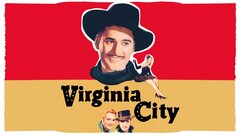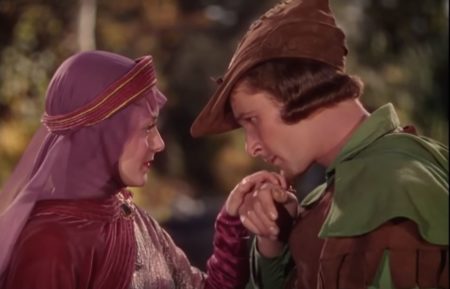Swashbuckling star Errol Flynn reached the heights of showbiz success in action-adventure flicks such as "Captain Blood" (1936), "The Adventures of Robin Hood" (1938) and pseudo-historical films such as "The Charge of the Light Brigade" (1936) and "They Died With Their Boots On" (1941).
He was born Errol Leslie Thomson Flynn in Hobart, Tasmania, Australia, on June 20, 1909. His marine biologist father, Theodore Flynn, taught at the local college, while Errol grew up distant from his mother, Mary Lily Flynn, who at one point branded him "a nasty little boy." She left the family not long after they moved to Sydney in 1920 and, while he maintained a good relationship with his father, his studies faltered as he began developing what would become his loveable-rake personality. He became sexually active early, fought at got expelled from school, ran into trouble when caught embezzling from a menial job and, just 17, bolted for New Guinea, then amid a latter-day gold rush. (He found no gold, but, by his sometimes fabulous recounting in his autobiography My Wicked, Wicked Ways), this led to early intrigues - including life-threatening bouts with the law and cuckolded husbands - and a whirl of jobs, including diamond-smuggler, pearl-diver, reporter, bird-trapper, gigolo and charter-boat captain.
As the latter, his chiseled looks caught the attention of an Australian movie producer, who cast him in "In the Wake of The Bounty" (1933) as famed mutineer Fletcher Christian (one of Christian's crewmembers was actually an ancestor of Flynn). He continued his prodigal hand-to-mouth meanderings, from China to India to France, then England, where he found some stage work, which led to the lead in a B-film by Warner Bros.' UK studio, "Murder at Monte Carlo" (1935). This got the attention of Warner's stateside brass, which decided to import Flynn. He met Lili Damita, a tempestuous French actress eight years his senior, on the ship to the U.
S and they commenced a torrid relationship, climaxing in a June 1935 marriage. Not long into his WB tenure, Robert Donat flaked on the lead in the upcoming sea adventure "Captain Blood," leading the studio, after exhausting all options, to go with its Aussie newcomer. Flynn, nervous to start off with, clashed with director Michael Curtiz, even as he played practical jokes on his 19-year-old limpid-eyed love-interest Olivia de Havilland. They demonstrated such on-screen spark - which manifested off-screen, but de Havilland has long intimated it never went beyond teasing and fervent flirtation - that WB codified the two, plus Curtiz, as a winning formula, to be reconstituted the next year in "The Charge of the Light Brigade."
The second of Flynn's 12 pictures with Curtiz - a relationship of mutual loathing that would escalate into physical tussles - and of eight co-starring de Havilland, "Charge" would also be the first of a succession of historically-based adventure films that gaily shredded history. "Charge" had Flynn and brigade saving the day and assuring victory at the Crimean War's battle of Balaklava, versus the criminal disaster the charge actually was. "Santa Fe Trail" (1940) and "They Died With Their Boots On" would be similarly cavalier, the first a sanitized, racially condescending account of future Civil War f s Jeb Stuart (Flynn) and George Custer (Ronald Reagan) tracking down terroristic abolitionist John Brown; the second canonizing Custer (Flynn this time) amid his (historically less-than-heroic) Indian campaigns. He and Curtiz would do more pat Westerns such as "Dodge City" (1939) and even comedies such as "Four's a Crowd" (1938), but costume adventures would be the Flynn trademark, the likes of "The Prince and the Pauper" (1937), "The Adventures of Robin Hood" and "The Private Lives of Elizabeth and Essex" (1939), and another pirate outing, "The Sea Hawk" (1940), all featuring him at his dashing, fencing, anti-authoritarian best (in "Robin Hood," when de Havilland's Marian charges him with speaking treason, Flynn's title character giddily retorts, "Fluently!"). "Robin Hood" proved his blockbuster, shot in Technicolor and costing an unheard-of $2 million, but making a then-impressive $4 million at the box office. The garish "Elizabeth and Essex" put him opposite Bette Davis, an oil-and-water mix, Flynn the arrogant upstart who made no pretense at art, Davis the intrepid artiste, later recounting how Flynn, upon their screen-kisses, would tongue-kiss her - a taboo in film then - with the taste of the previous night's bender in his mouth. In one scene that called for her to fake-slap him, Davis walloped Flynn, prompting a genuine near-violent reaction still evident in the film.
His lifestyle had already become notorious for epic partying and, in spite of his ongoing-if-tumultuous marriage, his prolific sexual appetites (with partners of both sexes, tabloid-scented biographies alleged in more recent years, though widely disputed). He and Damita would reconcile for brief periods, in one of them producing a son, Sean, but finally divorced in 1942. Flynn's raucous circle of friends included actors Bruce Cabot, Guinn Williams and the venerable John Barrymore, stuntman Buster Wiles, and director Raoul Walsh - who, after WB finally sprung Flynn from Curtiz's indenture, directed him in "Boots On" and the loveable-rogue boxing picture "Gentleman Jim." Walsh allegedly made Flynn the butt of one of history's most legendary practical jokes; just after the May 1942 death of Barrymore, Walsh "borrowed" Barrymore's corpse from the funeral home, propped it in a chair in Flynn's house with a lit cigarette just before the latter drunkenly stumbled in, to be scared witless. But 1942 had more discomfiture than that in store for Flynn. With the U.S. newly entered into World War II, he found his enlistment rejected, diagnosed with a weak heart. With the star a newly minted U.S. citizen, this threatened to subvert his heroic image and stymied Flynn's ability to make good on his anti-fascist sentiments, sharpened during a 1937 trip to Spain during the country's tragic civil war. Then, in the fall of 1942, police in Santa Monica turned up a missing person, Betty Hansen, a 17-year-old Midwestern girl who had come to visit her sister and disappeared. They found among her possessions the unlisted phone numbers of Flynn and Cabot. Hansen claimed she met them in September at a party at Cabot's house, where she had sex with Flynn. Soon thereafter, the L.A. County district attorney unearthed a previous allegation of the family of now-16-year-old Peggy Satterlee, who claimed she had had sex with Flynn during a weekend-long party on his yacht. Flynn was charged with statutory rape and, during the ensuing media-circus trial, reportedly kept a plane waiting at a nearby airstrip to take him to Mexico. But defense-attorney-to-the-stars Jerry Giesler effectively cast doubts on the motives and veracity of both girls, Flynn earnestly denied having sex with either, and the jury acquitted him. Curiously, during the trial Flynn got acquainted with 18-year-old Nora Eddington, daughter of the county sheriff who worked at the Hall of Justice, and they married in August 1943. They would have a daughter, Rory, who insisted years later that her mother went into it with eyes open: "[S]he told him right upfront, 'You can do whatever you want when you're at the studio - but the one thing you can never do is bring it home!'"The scandal would introduce the phrase "in like Flynn" into American vernacular as a euphemism for successful seduction. He, Walsh and WB would attempt to compensate for his apparent wartime frivolity by pitting him against the Germans and Japanese in a series of movies, mostly taut, espionage-themed actioners like "Desperate Journey" (1942), "Northern Pursuit" (1943) and "Objective, Burma!" (1945) - a rare World War II-era film that effectively renders war's horrors - but also a flop that some consider among his best films, "Uncertain Glory" (1944). Flynn saw the picture as one that would give him a chance to spread his thespian wings, a noir-y film that sets him as a morally ambivalent thief in Nazi-occupied France who agrees with an apolitical policeman to cop to an act of sabotage by the French resistance to spare villagers German reprisals, building tension as to whether the rogue will do the right thing or not. But his postwar outings would prove mediocre B fare, only returning him to dashing form as the freebooting lothario in "Adventures of Don Juan" (1948) and showing some non-action acting chops the next year on a loan-out to MGM as a cold, manipulative husband in "That Forsyte Woman." Loan-outs would tender his most notable efforts, such as another colonial adventure for MGM, "Kim" (1950), and Universal reviving his pirate adventurism with "Against All Flags" (1952). During the production, co-star Maureen O'Hara noted that Flynn exhibited consummate professionalism, prepped and ready with his lines to start the day, but would inevitably be drunk by 4pm. One story has him, when booze was banned from the set, bringing oranges injected with vodka. "Flags" did well enough that WB greenlit a final Flynn swashbuckler under its imprint, "The Master of Ballantrae" (1953), but WB would abrogate his contract soon after. He attempted an ambitious comeback, a self-funded costume/action epic based on the Swiss myth, of William Tell, but other financing fell out and his own blown savings yielded only 30 minutes of film.
In the 1950s, his movie work would winnow down to indie films capitalizing on his stardom at the expense of reality, typically miscasting him in younger roles, while he tried his hand at TV, briefly hosting a UK TV show "The Errol Flynn Theatre" and doing guest-shots on American anthology shows - much of it just to stay on top of his mounting debts. His true - and best-received - swansongs would be roles close to his own circumstances, first in 1957 playing the lifeworn drunk in a film adaptation of Hemmingway's "The Sun Also Rises," and in 1958 playing his besotted old friend Barrymore in "Too Much, Too Soon." Damita won his house in an alimony suit, making one of his boats his new primary residence, and he spent much of his final years self-exiled to Jamaica with his third wife, Patrice Wymore, then sailing the world, avoiding creditors and possibly the law, given that his onboard companion, Beverly Aadland, (officially called his "protégé") was sixteen when he met her. She would star in his final film, the unwatchable tax write-off "Cuban Rebel Girls" (1959), ostensibly written by Flynn, who played himself as a war correspondent covering the revolution, and produced with the cooperation of Fidel Castro. In fall 1959, after a guest-appearance on "The Red Skelton Show" (CBS, 1951-71), Flynn flew to Vancouver, BC, where he had a prospect to buy his yacht for a much-needed cash-infusion, but abruptly fell ill there and, at age 50, died of heart attack. Doctors who examined him famously said his body bore the physical ravages of that of a 75-year-old.
Flynn's son Sean would briefly flirt with an acting career, one film curiously an Italian-made B-film called "Son of Captain Blood" (1962), but found his calling as a photojournalist, earning a reputation for fearlessness during the Vietnam war, and disappearing in Cambodia in 1970. Rory Flynn's son, also Sean, is currently an actor starring on the Nickelodeon show "Z y 101" (2005- ). In 1983 Peter O'Toole was nominated for an Academy Award, one more than Flynn, for "My Favorite Year" (1982), a sparkling comedy in which he played Alan Swann, a barely fictionalized version of an aging Errol Flynn, who bellows, "I'm not an actor - I'm a movie star!"



































































































































































































































































































































































































































































































































































































































































































































































